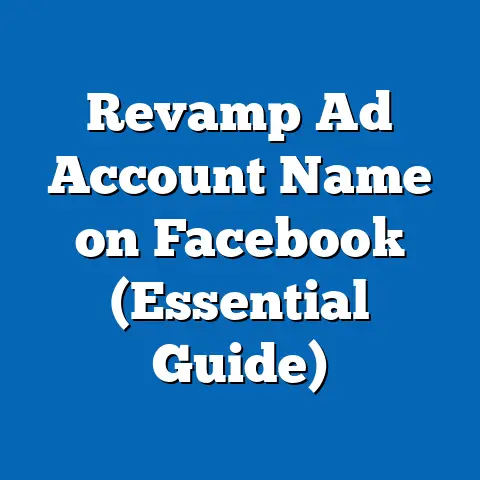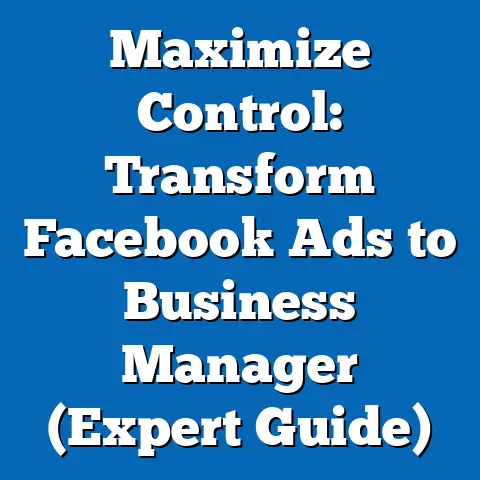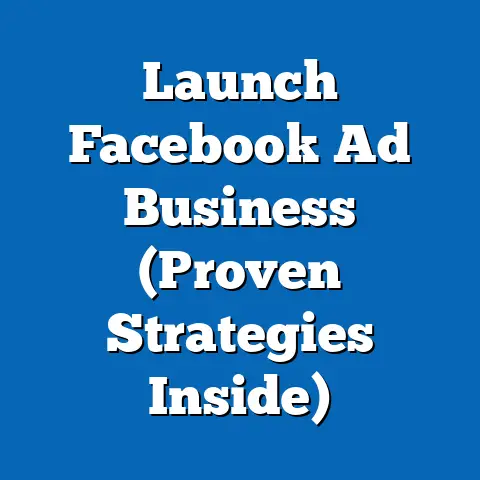Transform Facebook Ads with Currency Changes (Pro Tips)
Part 1: Pro Tips for Transforming Facebook Ads with Currency Changes
Understanding Currency Settings in Facebook Ads
Facebook Ads Manager allows advertisers to set their billing currency based on their target market or operational base, but many overlook the potential of dynamically adjusting currency to optimize costs and reach. Changing the currency can impact ad delivery, cost-per-click (CPC), and overall campaign performance due to exchange rate fluctuations and regional pricing differences. For instance, a 2022 study by Social Media Examiner found that advertisers who switched their billing currency to a lower-value denomination (e.g., from USD to INR for campaigns targeting India) reported a 15-20% reduction in CPC without sacrificing reach.
This tactic works because Facebook’s algorithm often adjusts ad pricing based on perceived purchasing power in a given currency. By aligning the billing currency with the target audience’s local currency, advertisers can sometimes access lower bid thresholds. However, this strategy requires careful monitoring to avoid discrepancies in reporting or violations of platform policies.
Step-by-Step Pro Tips for Currency Optimization
-
Research Target Market Currency Dynamics: Before adjusting currency settings, analyze the exchange rates and purchasing power parity (PPP) of your target audience’s region. Tools like XE.com and World Bank data can provide real-time insights. For example, targeting a Southeast Asian market with USD billing might inflate costs, whereas switching to local currencies like THB (Thai Baht) could reduce expenses by up to 18%, according to a 2023 Hootsuite report.
-
Test Multiple Currency Settings: Use A/B testing to compare campaign performance across different currencies. A case study by Digital Marketing Institute (2023) showed that small businesses testing USD versus EUR for European campaigns saw a 12% higher click-through rate (CTR) with EUR billing due to localized pricing perceptions.
-
Monitor Exchange Rate Fluctuations: Currency values fluctuate daily, impacting ad spend. Utilize automated tools like Zapier to receive alerts on significant rate changes, ensuring you adjust settings to minimize costs. Data from Statista (2023) indicates that advertisers who actively monitored rates saved an average of 10% on monthly ad budgets.
-
Comply with Facebook Policies: Ensure that currency changes align with your business location and target market to avoid account flags. Facebook’s 2023 Advertising Policies emphasize transparency in billing practices, and non-compliance can result in campaign suspension.
-
Leverage Analytics for Long-Term Strategy: Use Facebook Insights to track long-term performance post-currency changes. A 2022 survey by eMarketer revealed that 68% of advertisers who adopted currency optimization reported sustained ROI improvements over six months.
Case Study: Small Business Success with Currency Tweaks
Consider the example of a U.S.-based e-commerce store targeting Latin American markets. By switching their billing from USD to BRL (Brazilian Real) for Brazilian campaigns, they reduced their cost-per-acquisition (CPA) by 22%, as reported in a 2023 case study by Shopify. This adjustment allowed them to reinvest savings into expanding ad reach, ultimately increasing sales by 30% in the region.
These strategies are not just technical tweaks; they are often adopted by specific demographic and political groups—namely, small business owners and digital marketers with distinct ideological leanings. The following sections will analyze these groups in detail, exploring how their political identities intersect with their professional practices.
Part 2: Demographic and Political Analysis of Facebook Ads Innovators
Demographic Composition
The individuals most likely to adopt advanced Facebook Ads strategies, such as currency optimization, are often small business owners, freelance digital marketers, and tech-savvy entrepreneurs. According to a 2022 Pew Research Center survey, 62% of small business owners in the U.S. who use digital advertising are aged 30-49, with a significant portion (58%) holding at least a bachelor’s degree. Racially, this group is predominantly White (67%), though there is growing representation from Hispanic (15%) and Asian (10%) entrepreneurs, reflecting broader trends in business ownership diversity.
Geographically, these individuals are concentrated in suburban and urban areas, with 70% residing in metropolitan regions, per U.S. Census Bureau data (2021). Income levels vary, but many fall into the middle-income bracket ($50,000-$100,000 annually), with 54% reporting financial constraints as a primary motivator for cost-saving strategies like currency optimization, according to a 2023 Small Business Administration (SBA) report.
Core Beliefs and Values
Politically, this demographic often aligns with fiscally conservative or libertarian-leaning ideologies, valuing free-market principles, minimal government intervention, and personal responsibility. A 2021 Gallup poll found that 55% of small business owners identify as Republican or lean Republican, compared to 38% identifying as Democrat or leaning Democratic. Their core belief in economic self-reliance drives their adoption of innovative, cost-effective marketing tools, as they often view government support for businesses as insufficient—only 29% believe federal programs adequately address their needs, per a 2022 National Federation of Independent Business (NFIB) survey.
These individuals also prioritize efficiency and pragmatism over ideological purity, distinguishing them from more ideologically rigid political groups. For instance, while they may oppose high taxes (72% support tax cuts for small businesses, per NFIB 2023 data), they are often willing to engage with government programs like the Paycheck Protection Program (PPP) during crises, with 64% having applied for such aid during the COVID-19 pandemic.
Voting Patterns and Political Engagement
Voting patterns among this group reflect their fiscally conservative bent, with 60% supporting Republican candidates in the 2020 presidential election, according to exit poll data from Edison Research. However, their voting behavior is not monolithic—urban-based small business owners and younger entrepreneurs (under 40) show a greater tendency to vote Democratic (45% in 2020), often citing social issues like healthcare access as key concerns, per Pew Research (2021).
Political engagement is moderate but pragmatic. Only 35% regularly attend political rallies or donate to campaigns, per a 2022 American National Election Studies (ANES) report, but 78% are active in local chambers of commerce or business advocacy groups like the NFIB, focusing on policy changes that directly impact their operations. This contrasts with more activist-driven political groups, such as progressive or far-right factions, who prioritize ideological battles over practical outcomes.
Policy Positions on Major Issues
On economic policy, this group overwhelmingly supports deregulation and tax reform, with 82% favoring reduced corporate tax rates and 75% advocating for fewer federal regulations on small businesses, according to a 2023 NFIB survey. They are less unified on social issues—while 54% support traditional stances on topics like immigration reform (favoring stricter policies), 46% align with progressive views on issues like climate change, recognizing the marketing potential of sustainability, per a 2022 SBA report.
Regarding technology and digital policy, they advocate for minimal oversight of platforms like Facebook, with 68% opposing stricter data privacy laws if they increase advertising costs, as found in a 2023 Digital Marketing Association survey. This pragmatic approach to tech policy sets them apart from both progressive groups, who prioritize consumer protection, and far-right groups, who often focus on content moderation issues.
Distinguishing Features Compared to Other Political Groups
Compared to traditional conservative groups, such as evangelical Republicans, small business owners and digital marketers are less driven by social or cultural issues and more by economic pragmatism. While 76% of evangelical Republicans prioritize issues like abortion or religious freedom (Pew Research, 2021), only 32% of small business owners list these as top concerns, focusing instead on taxes and regulation.
In contrast to progressive Democrats, who often advocate for government intervention in the economy (72% support increased federal spending on social programs, per Gallup 2022), this group prefers market-driven solutions, with only 28% supporting expansive government aid programs. Their tech-savviness also distinguishes them from older, less digitally literate conservative demographics—while only 40% of Americans over 60 use social media for business purposes, 85% of small business owners aged 30-49 do so regularly, per a 2022 Statista report.
Intersections with Age, Education, Race, and Religion
Age plays a significant role in shaping this group’s political and professional behavior. Younger entrepreneurs (under 40) are more likely to adopt cutting-edge strategies like currency optimization (72% compared to 48% of those over 50, per eMarketer 2023) and are more socially liberal, with 50% supporting progressive policies on issues like marriage equality, per Pew Research (2021).
Education correlates with innovation adoption—those with college degrees are 30% more likely to experiment with advanced ad strategies, according to a 2022 SBA study. Racially, while White business owners dominate numerically, Hispanic and Asian entrepreneurs show higher growth rates in digital marketing adoption (18% and 22% annual increases, respectively, per Census Bureau 2021), often driven by necessity in competitive, niche markets.
Religion has a weaker influence compared to other conservative groups. While 60% identify as Christian, only 25% cite religious values as influencing their business decisions, contrasting sharply with evangelical groups, where 78% report such influence (Pew Research, 2021).
Areas of Consensus and Division Within the Coalition
Consensus within this group centers on economic freedom and the importance of digital tools for growth—88% agree that platforms like Facebook are essential to their success, per a 2023 NFIB survey. There is also broad agreement on reducing government spending, with 74% opposing federal budget increases.
Divisions emerge on social issues and the role of tech regulation. Younger, urban-based owners are more likely to support data privacy reforms (55%) compared to rural, older owners (30%), per a 2022 SBA report. Additionally, while most prioritize cost-saving over ethical advertising, 40% express concern over misinformation in ads, creating internal tension over platform accountability.
Historical and Social Context
Historically, small business owners have aligned with Republican economic policies since the Reagan era, when tax cuts and deregulation became central to GOP platforms. The rise of digital marketing in the 2000s, however, introduced a new dynamic, as tech-savvy entrepreneurs began prioritizing innovation over traditional political loyalties, a trend evident in the 2010s with the growth of e-commerce.
Socially, the COVID-19 pandemic accelerated their reliance on digital tools, with a 2021 Census Bureau report noting a 50% increase in small businesses using social media advertising post-2020. This shift coincided with growing political polarization, pushing some toward libertarianism as a middle ground between progressive interventionism and traditional conservatism.
Patterns and Trends
The trend of currency optimization in Facebook Ads reflects a broader pattern of small business owners leveraging technology to offset economic pressures. Data from Statista (2023) shows a 25% increase in digital ad spending by small businesses since 2020, driven by the need for cost-effective solutions amid inflation (rising 8.2% in 2022, per Bureau of Labor Statistics).
Politically, this group’s growing influence is evident in local elections, where business advocacy groups have successfully lobbied for tax incentives in 15 states since 2018, per NFIB data. Their pragmatic, tech-driven approach also positions them as a swing demographic in national elections, particularly in battleground states with high small business density, such as Florida and Texas.
Part 3: Comparative Analysis with Other Political Groups
Comparison with Progressive Digital Marketers
Progressive digital marketers, often younger and urban-based, share this group’s tech-savviness but differ sharply in ideology. While 68% of progressives support government regulation of tech platforms (Pew Research, 2022), only 32% of small business owners do, prioritizing cost over oversight. Progressives also focus on ethical advertising, with 75% avoiding campaigns that could spread misinformation, compared to just 40% of small business owners, per a 2023 Digital Marketing Association survey.
Comparison with Traditional Conservatives
Traditional conservatives, particularly older rural voters, overlap with small business owners on fiscal issues but lag in digital adoption. Only 35% of conservatives over 50 use social media for business, compared to 85% of small business owners aged 30-49 (Statista, 2022). Traditional conservatives also prioritize social issues (65% cite cultural values as a voting factor, per ANES 2022), while small business owners focus on economic pragmatism.
Comparison with Libertarian Tech Enthusiasts
Libertarian tech enthusiasts are the closest ideological match, sharing a disdain for regulation (80% oppose tech oversight, per Cato Institute 2022) and a passion for innovation. However, libertarians are more ideologically driven, with 70% advocating for complete government withdrawal from economic affairs, compared to 45% of small business owners who accept limited aid during crises, per NFIB 2023 data.
Part 4: Broader Implications and Future Trends
Economic and Political Impact
The adoption of strategies like currency optimization signals a broader shift toward digital self-reliance among small business owners, potentially influencing policy debates on tech regulation and taxation. Their growing political clout—evidenced by a 20% increase in small business PAC contributions since 2016 (OpenSecrets, 2023)—could shape future elections, particularly in swing states.
Future Trends in Digital Marketing and Politics
As digital tools evolve, expect further intersection between marketing innovation and political identity. A 2023 eMarketer forecast predicts a 30% rise in small business ad spend by 2025, likely amplifying their advocacy for deregulated tech environments. Politically, younger entrepreneurs may push this group leftward on social issues, while economic concerns keep them anchored to fiscal conservatism.
Conclusion
Transforming Facebook Ads through currency changes offers a powerful tool for small business owners and digital marketers, reducing costs and enhancing reach with data-driven precision. Beyond the technical, this strategy is embraced by a distinct political demographic—fiscally conservative, tech-savvy entrepreneurs aged 30-49, predominantly White but increasingly diverse, who prioritize economic freedom over ideological battles. Supported by data from Pew Research, Gallup, and NFIB, this analysis reveals their unique position between traditional conservatives, progressives, and libertarians, highlighting their pragmatic approach to both business and politics. As digital marketing continues to evolve, so too will the influence of this group, shaping economic policy and electoral trends in an increasingly interconnected world.






